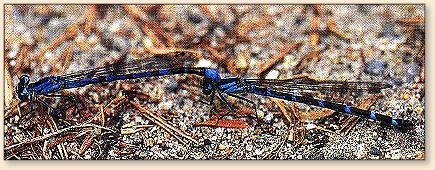|
Those damsels surviving the rigors of emergence
fly off to feed and mate. Accomplished fliers,
damsels carry on through the summer feeding
upon insects such as Chironomids and mosquitoes.
Damsels mate in a unique fashion. The male damsel
grasps the female just behind her head with a pair
of claspers located at the end of his abdomen. The
female bends her abdomen forward between the male's
legs to complete this intricate mating process. The
adults fly around in tandem for some time. Some
females deposit their eggs by dropping them over
the water, others crawl beneath the water and place
their eggs directly into the vegetation. Often still
attached to the male. During the mating rituals adults
end up stuck on the water's surface. Spent or drowned
adults lie flush on the water's surface with their
wings swept back forming a "V," providing an attractive
meal for trout under the right conditions.
The Lestidae and Coenagrionidae families are the most
widespread across western North America. For imitation
purposes they are nearly identical. The Lestid nymphs
are the more slender of the two and their tails are
longer. The only other notable difference is the
position of their labium. The Lestid nymph's labium
reaches further back between the legs in the retracted
position. Lestid nymphs seem to be the better swimmers
of the two and are capable of quick darts of speed
when needed.
Damselflies come in a rainbow of colors. As with most
aquatic organisms, local habitat is the deciding factor.
The most common colors of damsel nymphs include shades
of brown, olive and green. Nymphs in clear water lakes
lean towards a pale watery olive or green while those
from algae or tannin lakes are dark olive or brown.
Prowl the shoreline to see what the predominant color
is. Tenerals are a mustard brown or pale green color.
As the adult matures, its coloration changes, but not
all adult damsels are the familiar blue and black.
Some species are shades of green, brown, red or even
yellow.

A pair of mating damsels. The male grasps the female
behind her head with a pair of claspers.
Damselfly nymphs favored habitat is amongst shallow
weed beds in 15 feet of water or less. Lakes or ponds
with a healthy growth of long-stemmed vegetation such
as Potamageton and Tulles harbor dense populations of
damsel nymphs. Peering down into the water it is common
to see damsel nymphs sculling from one spot to another.
~ PR
More on Damselflies from Phil Rowley's excellent book,
Fly Patterns for Stillwaters next time.
Credits: Excerpt from Fly Patterns
for Stillwaters By Philip Rowley, published
by Frank Amato Publications. We appreciate use
permission.
|


